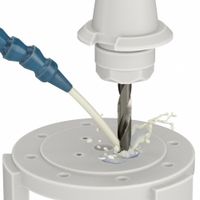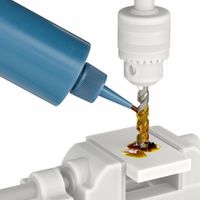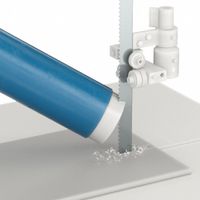Call +(254) 703 030 000 / 751 483 999 / 721 704 777
- Home
- Machining
- Metalworking Fluids
- Cutting Fluids
.....Read More
Frequently Asked Questions
What are cutting fluids used for in metalworking?
Cutting fluids are essential in metalworking processes to enhance performance and extend tool life. They serve several critical functions:
1. **Cooling**: Cutting fluids absorb and dissipate the heat generated during metal cutting operations. This cooling effect prevents overheating, which can lead to tool wear, deformation of the workpiece, and poor surface finish.
2. **Lubrication**: By reducing friction between the cutting tool and the workpiece, cutting fluids minimize tool wear and energy consumption. This lubrication helps achieve smoother cuts and extends the life of both the tool and the machine.
3. **Chip Removal**: Cutting fluids assist in flushing away metal chips and debris from the cutting area. This prevents chip re-cutting, which can damage the workpiece and tool, and ensures a cleaner working environment.
4. **Surface Finish**: The use of cutting fluids can improve the surface finish of the machined part by reducing tool marks and ensuring a more uniform cut.
5. **Corrosion Prevention**: Some cutting fluids contain additives that protect both the workpiece and the machine from rust and corrosion, especially important when working with ferrous metals.
6. **Tool Life Extension**: By reducing thermal and mechanical stresses on cutting tools, fluids help in prolonging their operational life, reducing the frequency of tool changes and downtime.
7. **Workpiece Integrity**: Cutting fluids help maintain the structural integrity of the workpiece by minimizing thermal distortion and stress.
8. **Operator Safety and Comfort**: Modern cutting fluids are formulated to be less hazardous, reducing fumes and skin irritation, thus improving the working conditions for operators.
Overall, cutting fluids are vital for efficient, precise, and cost-effective metalworking operations.
How do cutting fluids improve tool life?
Cutting fluids enhance tool life primarily through cooling, lubrication, and chip removal.
1. **Cooling**: Cutting operations generate significant heat due to friction and deformation. Excessive heat can lead to thermal expansion, loss of hardness, and premature tool wear. Cutting fluids absorb and dissipate this heat, maintaining a stable temperature and preventing thermal damage to both the tool and the workpiece.
2. **Lubrication**: Cutting fluids reduce friction between the tool and the workpiece. This lubrication minimizes the wear on the tool's cutting edge, reducing the risk of tool failure. By forming a thin film between the tool and the material, cutting fluids decrease the force required for cutting, which in turn reduces tool stress and prolongs tool life.
3. **Chip Removal**: Efficient chip removal is crucial in preventing tool damage. Cutting fluids help in flushing away chips from the cutting zone, preventing them from being re-cut or causing damage to the tool. This ensures a smoother cutting process and reduces the likelihood of tool breakage or chipping.
4. **Corrosion Prevention**: Some cutting fluids contain additives that prevent corrosion of the tool and workpiece. This is particularly important in operations involving metals susceptible to oxidation, as corrosion can weaken the tool and reduce its lifespan.
5. **Surface Finish**: By reducing friction and heat, cutting fluids contribute to a better surface finish on the workpiece. A smoother finish reduces the likelihood of tool wear due to surface irregularities, further extending tool life.
Overall, cutting fluids play a critical role in maintaining tool integrity, enhancing performance, and ensuring efficient and cost-effective machining operations.
What are the benefits of using ready-to-use cutting fluids?
Ready-to-use cutting fluids offer several benefits in machining and metalworking processes:
1. **Convenience**: These fluids are pre-mixed and ready for immediate use, eliminating the need for on-site mixing or dilution. This saves time and reduces the potential for errors in concentration, ensuring consistent performance.
2. **Consistency**: Since they are manufactured under controlled conditions, ready-to-use cutting fluids provide uniform quality and performance. This consistency helps in maintaining stable machining conditions and predictable tool life.
3. **Reduced Maintenance**: With no need for mixing, there is less equipment required for preparation, leading to lower maintenance costs and reduced downtime associated with equipment cleaning and maintenance.
4. **Improved Safety**: Pre-mixed fluids reduce the risk of handling concentrated chemicals, which can be hazardous. This enhances workplace safety by minimizing exposure to potentially harmful substances.
5. **Cost-Effectiveness**: Although the initial cost may be higher, the reduction in preparation time, equipment, and potential waste can lead to overall cost savings. Additionally, consistent fluid performance can extend tool life and improve surface finish, reducing rework and scrap rates.
6. **Environmental Benefits**: Ready-to-use fluids often come with optimized formulations that can be more environmentally friendly, reducing the environmental impact of disposal and spillage.
7. **Enhanced Performance**: These fluids are designed to provide optimal cooling, lubrication, and chip removal, which can improve machining efficiency, reduce heat generation, and enhance the quality of the finished product.
8. **Simplified Inventory Management**: With no need for separate components for mixing, inventory management becomes simpler, reducing the space and resources needed for storage.
Overall, ready-to-use cutting fluids streamline operations, enhance safety, and improve machining outcomes, making them a valuable choice for many industrial applications.
How do concentrated cutting fluids differ from ready-to-use ones?
Concentrated cutting fluids and ready-to-use cutting fluids differ primarily in their formulation, application, and preparation requirements.
Concentrated cutting fluids are highly concentrated solutions or emulsions that require dilution with water or other solvents before use. They are typically supplied in a concentrated form to allow customization of the fluid's properties based on specific machining needs. Users can adjust the concentration to achieve the desired balance of cooling, lubrication, and corrosion protection. This flexibility makes concentrated fluids suitable for a wide range of machining operations and materials. However, they require careful mixing and monitoring to maintain the correct concentration and performance, which can be labor-intensive and requires proper equipment and training.
Ready-to-use cutting fluids, on the other hand, are pre-mixed and supplied in a form that can be used directly without any further preparation. These fluids are convenient and save time as they eliminate the need for dilution and mixing. They are ideal for smaller operations or situations where consistent performance is required without the need for adjustments. However, they offer less flexibility in terms of customization and may not be as cost-effective for large-scale operations due to the higher initial cost per unit volume compared to concentrated fluids.
In summary, concentrated cutting fluids offer flexibility and cost-effectiveness for large-scale or varied operations but require careful handling and preparation. Ready-to-use fluids provide convenience and consistency, making them suitable for smaller or less variable applications.
What types of cutting fluids are available?
Cutting fluids are essential in machining processes to reduce heat and friction, improve tool life, and enhance surface finish. The main types of cutting fluids include:
1. **Soluble Oils**: These are oil-based fluids that emulsify in water, forming a milky solution. They offer good lubrication and cooling properties and are versatile for various machining operations. However, they can be prone to bacterial growth and require regular maintenance.
2. **Synthetic Fluids**: Composed entirely of chemical compounds and contain no petroleum or mineral oil. They provide excellent cooling and are ideal for high-speed operations. They are less prone to bacterial growth but may offer less lubrication compared to oil-based fluids.
3. **Semi-Synthetic Fluids**: These are a blend of synthetic fluids and soluble oils, offering a balance between cooling and lubrication. They provide better stability and are less prone to bacterial growth than soluble oils.
4. **Straight Oils**: These are non-emulsifiable oils used in their pure form. They provide excellent lubrication and are ideal for low-speed, high-pressure applications. However, they offer limited cooling and can produce smoke and mist.
5. **Mineral Oils**: Derived from refining crude oil, these are used in straight oils and some soluble oils. They provide good lubrication but may not be as effective in cooling as synthetic options.
6. **Vegetable Oils**: These are biodegradable and environmentally friendly, offering good lubrication. They are increasingly used as an alternative to mineral oils in certain applications.
7. **Micro-Emulsions**: These are advanced cutting fluids that form very fine emulsions, providing excellent cooling and lubrication. They are stable and less prone to bacterial growth.
Each type of cutting fluid has its advantages and limitations, and the choice depends on the specific machining operation, material, and environmental considerations. Regular maintenance and monitoring are crucial to ensure optimal performance and longevity of the cutting fluids.
How do cutting fluids improve surface finish?
Cutting fluids improve surface finish through several mechanisms. Firstly, they provide lubrication, reducing friction between the cutting tool and the workpiece. This minimizes tool wear and prevents the formation of built-up edges, which can mar the surface finish. By maintaining a smooth interaction between the tool and material, cutting fluids help achieve a finer surface texture.
Secondly, cutting fluids act as coolants, dissipating the heat generated during machining. Excessive heat can cause thermal expansion and deformation of both the tool and workpiece, leading to poor surface quality. By controlling the temperature, cutting fluids help maintain dimensional accuracy and prevent surface defects such as burns or discoloration.
Additionally, cutting fluids assist in chip evacuation. They help flush away chips from the cutting zone, preventing them from being recut or trapped between the tool and workpiece. This reduces the risk of surface scratches and ensures a cleaner finish.
Cutting fluids also protect against corrosion. They form a protective barrier on the workpiece surface, preventing oxidation and rust, which can degrade surface quality over time.
Furthermore, cutting fluids can enhance the cutting process by improving tool life. A longer-lasting tool maintains its sharpness and precision, contributing to a consistent and high-quality surface finish throughout the machining operation.
In summary, cutting fluids improve surface finish by providing lubrication, cooling, chip evacuation, corrosion protection, and extending tool life, all of which contribute to a smoother, more precise, and defect-free surface on the machined workpiece.
What is the role of cutting fluids in chip evacuation?
Cutting fluids play a crucial role in chip evacuation during machining processes. Their primary function is to facilitate the smooth removal of chips from the cutting zone, which is essential for maintaining tool life, surface finish, and overall machining efficiency.
Firstly, cutting fluids act as lubricants, reducing friction between the cutting tool and the workpiece. This lubrication minimizes the adhesion of chips to the tool, allowing them to be more easily removed from the cutting area. By reducing friction, cutting fluids also decrease the heat generated during machining, which can otherwise cause chips to weld to the tool or workpiece, complicating their removal.
Secondly, cutting fluids serve as coolants, dissipating the heat generated during the cutting process. Excessive heat can lead to thermal expansion of the workpiece and tool, affecting dimensional accuracy and causing chips to become more difficult to evacuate. By cooling the cutting zone, cutting fluids help maintain optimal temperatures, preventing chips from becoming too soft or sticky, which aids in their efficient removal.
Additionally, cutting fluids help in flushing away chips from the cutting area. The fluid's flow can physically carry chips away from the tool and workpiece, preventing them from being recut or causing damage to the machined surface. This flushing action is particularly important in high-speed machining operations where chip accumulation can quickly lead to tool wear or breakage.
In summary, cutting fluids enhance chip evacuation by providing lubrication, cooling, and flushing action, all of which contribute to improved machining performance, tool longevity, and surface quality.


